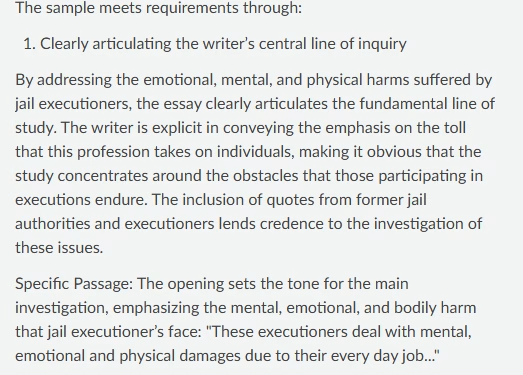Assignment 20 part one: Bringing things into focus
Again, the end goal for this unit: to produce a scholarly essay that articulates a research interest, summarizes and critically-engages sources in response to that interest, and draws on that engagement in support of making an argument in relation to those sources and your research interest.
Note: at the end of this assignment, you will be prompted to post your draft so your instructor can give you feedback. Don’t forget!
And here again are the requirements in detail (with tips for meeting the requirements in blue):
- Clearly articulate the writer’s central line of inquiry (explain in detail what you are trying to learn through examining and evaluating the perspectives of your sources)
- Maintain a clear purpose for writing that grows out of the writer’s inquiry (explain how the other researchers interested in your topic–the research community–will benefit from the work you’re doing)
- Make strategic composing decisions in response to the writer’s rhetorical situation (shape your essay so that your readers–the community of researchers interested in your topic–will find it relevant, credible, and persuasive)
- Provide relevant background information and definitions of key terms (give background information about your sources, your topic, and identify and explain any necessary key terms)
- Introduce, summarize, and otherwise integrate sources effectively and ethically, through paraphrase and direct quotation, and provide breakdowns of their arguments (just as you learned to do in the first unit, give your sources’ full names when you first mention them, share the titles of their works, identify the claims they make and the evidence they use to support those claims, and summarize their perspectives through paraphrase and direct quotation)
- Critically engage sources’ perspectives through interpretation, analysis, and critique in service of making a logical, well-supported argument that makes connections between sources and contributes to the conversation taking place around the writer’s topic (go beyond summary to evaluate your sources’ perspectives and weigh their helpfulness in the context of your inquiry in support of making an argument that other researchers will find new and useful, and compare, contrast, or otherwise explain connections between sources in ways that produce new insight)
- Meet academic expectations for clarity, cohesion, organization, paragraph structure, grammar, and mechanics (make sure your draft is organized, flows well, makes connections, and is grammatically correct)
- Properly cite sources—both in-text and through an accompanying works cited page—in accordance with MLA, APA, or Chicago Manual of Style guidelines (see the Library website (Links to an external site.), OWL at Purdue (Links to an external site.), or other resources for guidance)
- Achieve a length of between 1500 and 2400 words (6-10 pages)
- Word or Google doc, double spaced, 12pt font
Assignment 20 part one: Bringing things into focus-Read & Discuss
Step 1: Read this sample research essay Download sample research essay–an essay produced by a student just like you, in a class just like this, and as the final product for this same unit (except with different course texts and thus with a different course theme). As you read, evaluate the sample according to the assignment requirements above (though you can ignore the last two requirements).
Step 2: Either in writing or recording (for the latter, click on the Record/Upload Media icon above), identify two of the assignment requirements above that the sample essay best meets and explain why, giving a thorough explanation and referring to specific wording from the requirements and specific passages from the text.
Then, again in either writing or recorded form, identify the two requirements you think it struggles most with and, again, explain why, giving a thorough explanation and referring to specific wording from the requirements and specific passages from the text.
Each post for this step–whether in written or recorded form–should equate to a paragraph’s worth of writing.
Step 3: Respond to TWO of your peer’s posts, explaining what they helped you to see about the sample and assignment requirements that you hadn’t noticed and how you plan to apply that newfound perspective to your draft.
As with the previous step, each post–whether in written or recorded form–should equate to a paragraph’s worth of writing.
Write
Drawing on the perspective you developed in the discussion, read through your draft and take notes on things you think you might need to change, add, or delete in order to make it stronger in relation to the Unit 3 Final Product Requirements (in the For Your Reference section above).
Then, continue the same process as in the previous assignments, responding to your notes through revising and adding to your draft. You will only get one more shot at this project, so for this assignment, try to produce a complete–if not perfect–draft. Post your draft to this assigment so your instructor can give you feedback, and consider getting further help with it at the Composition and Literature CenterLinks to an external site..
Answer Preview-Assignment 20 part one: Bringing things into focus-ENGL-121-N201

